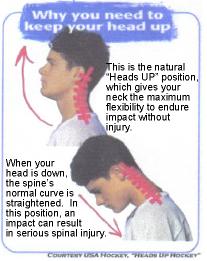
 |
HEADS UP
DON'T DUCK! |
 |
 |
|

|
How spinal injuries
happen in hockey The upper spinal column
has a
natural curve, which lends So that's the basis for
Rule One of Heads
Up Hockey: Heads Up — Don't Duck! 1. Charles H Tator et.al.,
Spinal
Injuries Due To Hockey. Canadian Journal of
Neurological
Sciences; 11:34-41. |
 |
Most people do not relate playing ice hockey with spinal cord injuries in the neck -- they don’t happen often. But when a severe injury like a spinal cord injury does occur, the question is: What preventive measures could have been taken?
PLAYERS . . .
COACHES . . .
PARENTS . . .
Can Prevention be Expected?
Prevention is usually possible, and should be the first thought in a player’s mind when entering the rink. Think of the countless hours spent skating, weight training, stretching, competing, and studying the sport, so the player can be prepared when the referee blows the first whistle at the start of the game. Knowing how to protect yourself against spinal cord injury is no different than knowing which goal to score against.
What Kind of Spinal Cord Injury Is Caused?
Cervical (neck) spinal cord injuries, though infrequent, can be devastating. These most often occur when a player lowers his head or tucks his chin to his chest, causing the vertebrae (bone segments of the spinal column that surround the spinal cord) to align in a straight line, and then collides head first into either another player, boards, or goal posts. This force (called axial compression) is transmitted to the aligned vertebrae, and, with minimal force, can result in the fracture, or breaking, of one of the cervical vertebrae. When the vertebra fractures, it can cause compression on the spinal cord, and it is this compression that results in paralysis.
It is rare that this injury occurs when the neck is in a normal or neutral position -- HEADS UP!
Is There Any Type of Protective Equipment?
At present, there is no protective equipment that a player can use to prevent a cervical spine injury. Helmets can protect a player from concussions but do not protect against cervical spinal cord injury.
The best form of protection is to be aware of the danger involved and keep your HEAD UP!
For copies of this brochure, please contact:
The Massachusetts Medical Society Department of Public Health and
Education at (781) 434-7373.
Sponsors:
Massachusetts Medical Society
Massachusetts Interscholastic Athletic Association (MIAA)
Massachusetts Hockey
New England Ice Skating Managers Association


Produced by the Massachusetts Medical Society in conjunction with Massachusetts Hockey.
This information may be duplicated for distribution w/out
profit.